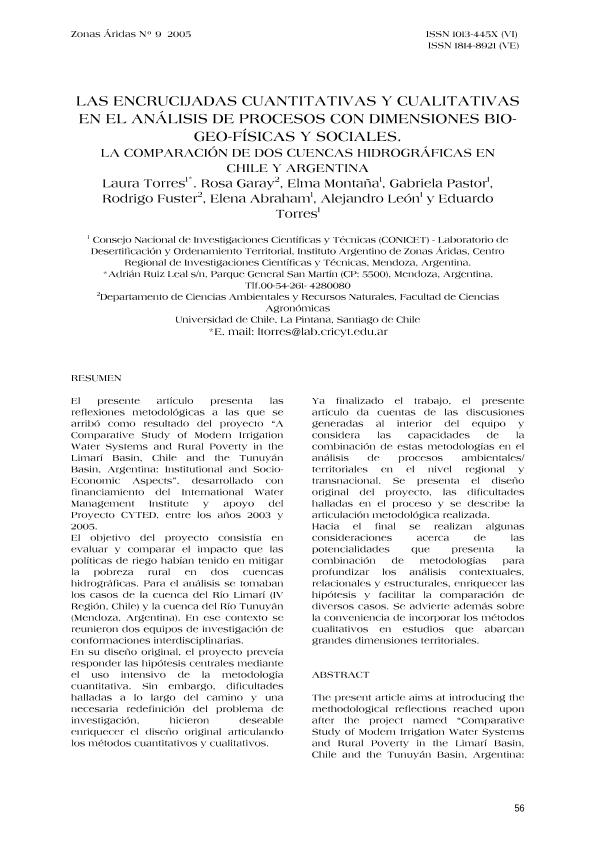Artículo
El presente artículo presenta las reflexiones metodológicas a las que se arribó como resultado del proyecto “A Comparative Study of Modern Irrigation Water Systems and Rural Poverty in the Limarí Basin, Chile and the Tunuyán Basin, Argentina: Institutional and SocioEconomic Aspects”, desarrollado con financiamiento del International Water Management Institute y apoyo del Proyecto CYTED, entre los años 2003 y 2005. El objetivo del proyecto consistía en evaluar y comparar el impacto que las políticas de riego habían tenido en mitigar la pobreza rural en dos cuencas hidrográficas. Para el análisis se tomaban los casos de la cuenca del Río Limarí (IV Región, Chile) y la cuenca del Río Tunuyán (Mendoza, Argentina). En ese contexto se reunieron dos equipos de investigación de conformaciones interdisciplinarias. En su diseño original, el proyecto preveía responder las hipótesis centrales mediante el uso intensivo de la metodología cuantitativa. Sin embargo, dificultades halladas a lo largo del camino y una necesaria redefinición del problema de investigación, hicieron deseable enriquecer el diseño original articulando los métodos cuantitativos y cualitativos. Ya finalizado el trabajo, el presente artículo da cuentas de las discusiones generadas al interior del equipo y considera las capacidades de la combinación de estas metodologías en el análisis de procesos ambientales/ territoriales en el nivel regional y transnacional. Se presenta el diseño original del proyecto, las dificultades halladas en el proceso y se describe la articulación metodológica realizada. Hacia el final se realizan algunas consideraciones acerca de las potencialidades que presenta la combinación de metodologías para profundizar los análisis contextuales, relacionales y estructurales, enriquecer las hipótesis y facilitar la comparación de diversos casos. Se advierte además sobre la conveniencia de incorporar los métodos cualitativos en estudios que abarcan grandes dimensiones territoriales. The present article aims at introducing the methodological reflections reached upon after the project named “Comparative Study of Modern Irrigation Water Systems and Rural Poverty in the Limarí Basin, Chile and the Tunuyán Basin, Argentina: Institutional and Socio-Economic Aspects". This project was developed thanks to the financial support of the International Water Management Institute and the backing up of a CYTED Project between 2003 and 2005. The aim of the project was assessing and comparing the impact that irrigation policies had had on relieving rural poverty along two hydrographic basins: the Limarí River basin (IV Region in Chile) and the Tunuyán River basin (in Mendoza, Argentina) ..Two interdisciplinary research groups met within this objective. On the first stages of the project, an intensive use of quantitative methodology was expected to respond to the central hypotheses. However, a redefinition of the research problem was necessary and an interrelation among quantitative and qualitative methods was achieved to enrich the original design. The present article recounts the discussions held within the groups, thus acknowledging the capacities arising from the combination of these methodologies for environmental and territorial processes appraisal at regional and transnational levels. The original design of the project is presented, in addition to the impediments appearing during the process, to lastly give an account of the methodological interrelation carried out. Towards the end, in order to enrich the existing hypotheses and paving the way towards the assessment of various cases, we claim as meritorious the combination of methodologies for delving into contextual, relational and structural analyses. The convenience to include qualitative methods in research works carried out in large territories is highlighted.
Las encrucijadas cuantitativas y cualitativas en el análisis de procesos con dimensiones bio-geo-físicas y sociales: La comparación de dos cuencas hidrográficas en Chile y Argentina
Torres, Laura María del Rosario ; Garay, Rosa; Montaña, Elma Carmen
; Garay, Rosa; Montaña, Elma Carmen ; Pastor, Gabriela Claudia
; Pastor, Gabriela Claudia ; Fuster, Rodrigo; Abraham, Elena Maria
; Fuster, Rodrigo; Abraham, Elena Maria ; León, Alejandro; Torres, Eduardo Rosember
; León, Alejandro; Torres, Eduardo Rosember
 ; Garay, Rosa; Montaña, Elma Carmen
; Garay, Rosa; Montaña, Elma Carmen ; Pastor, Gabriela Claudia
; Pastor, Gabriela Claudia ; Fuster, Rodrigo; Abraham, Elena Maria
; Fuster, Rodrigo; Abraham, Elena Maria ; León, Alejandro; Torres, Eduardo Rosember
; León, Alejandro; Torres, Eduardo Rosember
Fecha de publicación:
12/2005
Editorial:
Universidad Agraria La Molina
Revista:
Zonas Áridas
ISSN:
1013-445X
e-ISSN:
1814-8921
Idioma:
Español
Tipo de recurso:
Artículo publicado
Clasificación temática:
Resumen
Palabras clave:
MEDIO AMBIENTE
,
TERRITORIO
,
MENDOZA
Archivos asociados
Licencia
Identificadores
Colecciones
Articulos(CCT - MENDOZA)
Articulos de CTRO.CIENTIFICO TECNOL.CONICET - MENDOZA
Articulos de CTRO.CIENTIFICO TECNOL.CONICET - MENDOZA
Articulos(IADIZA)
Articulos de INST. ARG DE INVEST. DE LAS ZONAS ARIDAS
Articulos de INST. ARG DE INVEST. DE LAS ZONAS ARIDAS
Articulos(INCIHUSA)
Articulos de INST. DE CS. HUMANAS, SOC. Y AMBIENTALES
Articulos de INST. DE CS. HUMANAS, SOC. Y AMBIENTALES
Citación
Torres, Laura María del Rosario; Garay, Rosa; Montaña, Elma Carmen; Pastor, Gabriela Claudia; Fuster, Rodrigo; et al.; Las encrucijadas cuantitativas y cualitativas en el análisis de procesos con dimensiones bio-geo-físicas y sociales: La comparación de dos cuencas hidrográficas en Chile y Argentina; Universidad Agraria La Molina; Zonas Áridas; 9; 12-2005; 56-70
Compartir
Altmétricas



